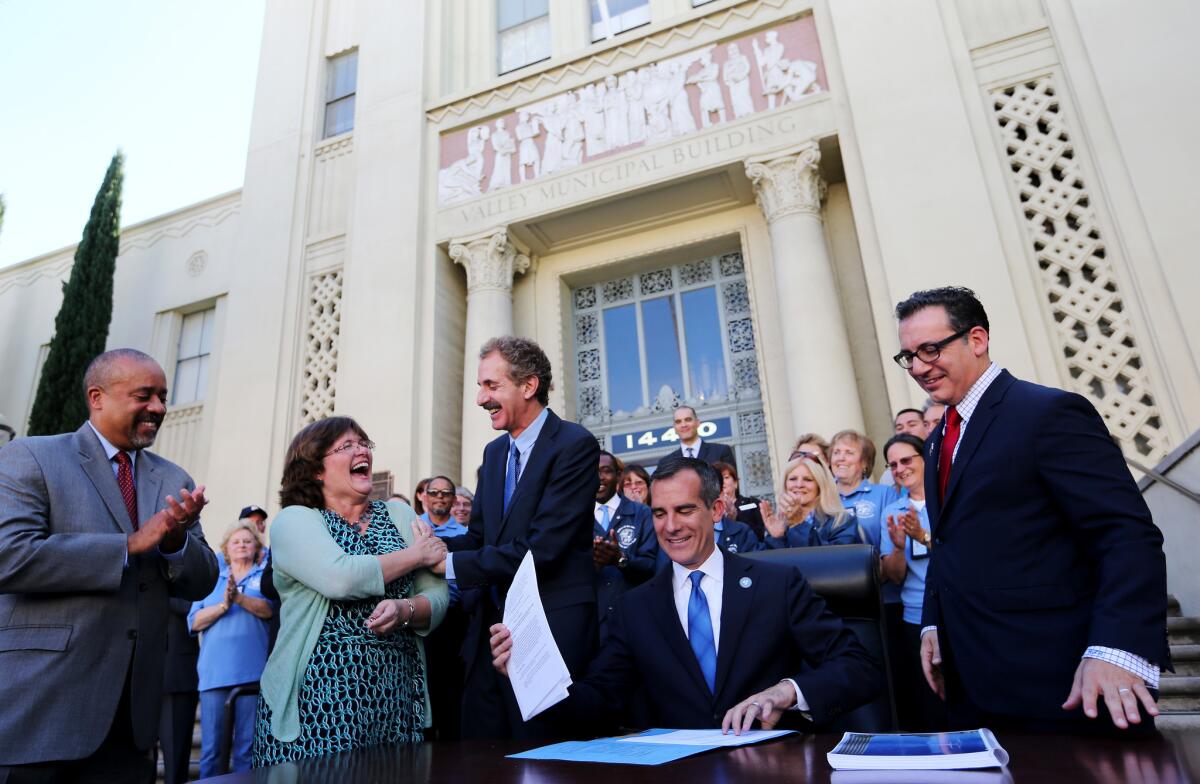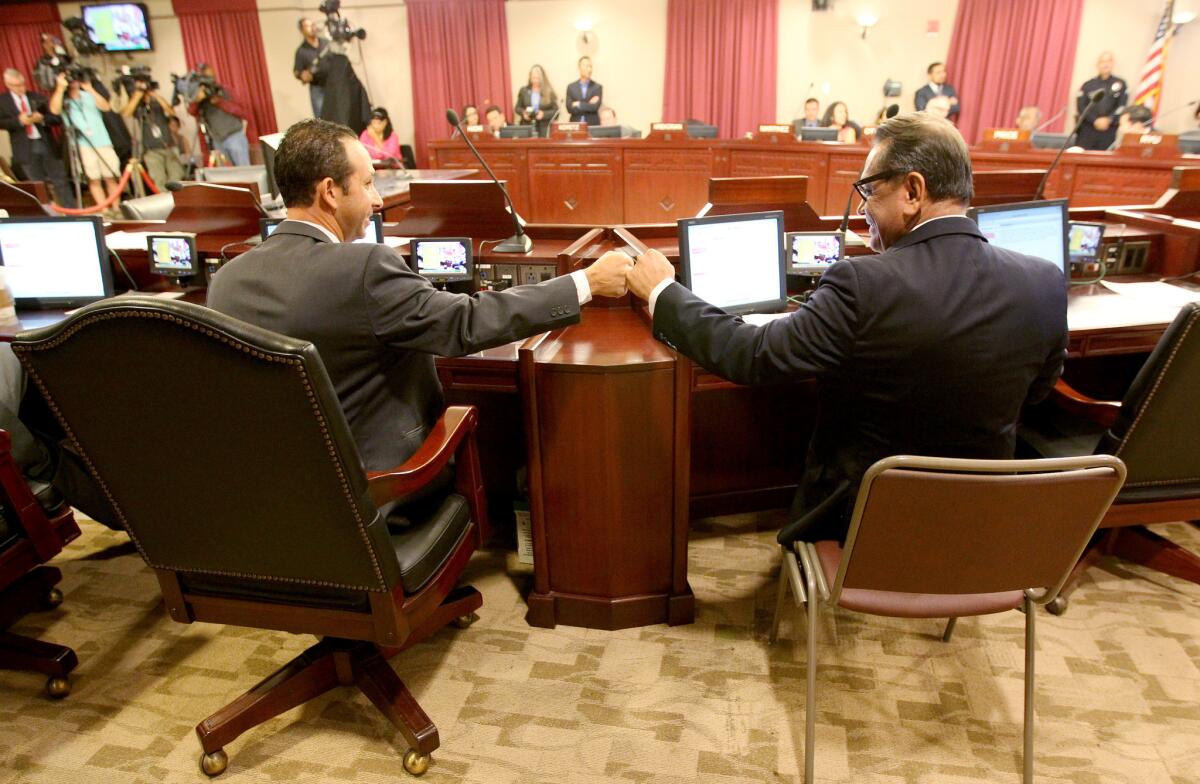Los Angeles will have the nation’s toughest earthquake safety rules

Lucy Jones, U.S. Geological Survey seismologist, second from left, celebrates with City Atty. Mike Feuer, center, as Mayor Eric Garcetti signs sweeping legislation to require earthquake retrofits on 15,000 buildings in Los Angeles on Friday.
- Share via
In a stark recognition of Los Angeles’ vulnerability to a major earthquake, the city on Friday enacted the nation’s most sweeping seismic regulations, requiring an estimated 15,000 buildings be retrofitted so they will better withstand violent shaking.
The unanimous vote by the Los Angeles City Council caps decades of efforts to strengthen two types of buildings that pose the most serious potential for loss of life in a big quake: Brittle concrete buildings that dot L.A.’s major boulevards and the boxy wood-frame apartment complexes built on top of carports. More than 65 people died when these types of buildings collapsed during quakes in 1971 and 1994.
The action marked a political and psychological milestone for a city that is at the center of earthquake country yet has a tradition of keeping those dangers out of mind.
Several times over the last two decades, efforts to require this type of retrofitting — or simply identify vulnerable buildings — died at City Hall over objections from property owners.
Garcetti said that by passing the law, Los Angeles “finally took our head out of the sand.”
“Today’s actions will save lives,” he said in an interview before signing the ordinance into law. “I’m not interested in making history or having the toughest laws. I’m interested in preserving our city’s ability to survive and thrive after an earthquake.”

City Councilmen Mitch Englander, left, and Gil Cedillo celebrate the passage of sweeping legislation to require earthquake retrofits on 15,000 buildings in Los Angeles during a council meeting in Van Nuys.
Under the law, property owners will have seven years to fix wood apartments and 25 years to fix concrete buildings. The city has already identified about 13,500 apartment complexes that officials suspect need repairs. A Times investigation in 2013 found more than 1,000 older concrete structures — including landmark buildings in downtown, Hollywood and Westwood — that require close scrutiny for retrofitting.
Owners will be required to find a way to pay for the work, which can range from $60,000 to $130,000 for wood apartments and millions of dollars for large concrete towers.
While renters and owners remained concerned about their costs, there has been a growing recognition from both groups that retrofitting was necessary.
“We want the buildings to be safe,” Martha Cox-Nitikman of the Building Owners and Managers Assn. of Greater Los Angeles said earlier this week. “But we need to figure out how we get people there without ruining businesses.”
The City Council is still mulling exactly how the retrofit costs will be shared. The law currently allows owners to increase monthly rents by up to $75 to pay for required earthquake retrofits, but both sides say they do not think Los Angeles renters can afford such a hike.
The city’s housing department has suggested that renters and owners pay for the retrofit on a 50-50 basis, allowing owners to charge a monthly maximum surcharge of $38 to pay for the seismic retrofit.
To help pay for the costs, apartment groups are looking for additional financial support, such as breaks on property and state income taxes and business license and building permit fees for owners who retrofit.
One key bill being considered by Gov. Jerry Brown is AB 428 by Assemblyman Adrian Nazarian (D-Sherman Oaks), which would allow owners to apply for a tax break equal to 30% of the retrofit costs. If Brown wants to veto the legislation, he must do it by Sunday.
Renters are also hoping that additional financial help will enable owners to pay the majority, if not all, of the cost of the retrofit.
“Clearly, we need to make these buildings safe. And a voluntary ordinance hasn’t been working,” said Larry Gross, executive director of the Coalition for Economic Survival. “This has all been about not whether to do it, but who pays, and what the impact of the costs are going to be on both the landlords and the tenants.”
Owners of concrete buildings will face a significantly steeper price tag. Building owners are hoping the city will give incentives, such as waiving the city’s gross receipts tax for businesses to move back into retrofitted buildings after they are vacated for the construction work. (Retrofits are simpler for wood apartments and generally don’t require a tenant to move out.)
Just a decade ago, the City Council did not support even counting the number of brittle concrete buildings in Los Angeles. Some business interests remained skeptical that concrete buildings posed a real risk of collapse.
But in 2011, the deadly nature of concrete buildings became clear again when an earthquake struck New Zealand’s third-largest city, Christchurch. The collapse of two concrete office towers alone killed 133 people.
Following that earthquake, The Times embarked on an investigation to see how many concrete buildings there were in Los Angeles, and establish where they were, because there was no publicly available list of these buildings. A team of Times reporters mined thousands of city and county records to find more than 1,000 buildings in Los Angeles that appeared to be concrete. The Times did further analysis of a sample of buildings, and only a small fraction had been retrofitted.
Soon after, Garcetti began an expansive campaign to address earthquake safety and appointed U.S. Geological Survey seismologist Lucy Jones as his earthquake science advisor. Jones, who has been a reassuring voice on Southern California radio and television stations after earthquakes, began canvassing the city, bluntly warning residents and owners of how dangerous it would be to do nothing.
“They are the deadliest buildings when they fall,” Jones said of concrete buildings at one of her meetings. “Because concrete is heavy, they kill people.”
Concrete buildings are considered so potentially dangerous because without enough reinforcing steel, chunks of concrete can burst from support columns, causing such buildings to collapse.
To determine whether a concrete building needs retrofitting, owners may have to spend as much as $100,000 on a structural study to ascertain what is inside the columns.
They would have to hire engineers who might install angled steel beams to provide more support, like an exoskeleton. Another solution could be the addition of sturdy interior concrete walls that stretch from the ground to the roof. The fixes could cost $1 million or more. Occupants probably would have to move out during the renovation, at an additional cost.
As Garcetti began his effort, university researchers who had been assembling a first-of-its-kind list of older concrete buildings for research—the first comprehensive attempt to catalog the scope of the problem—agreed to release it to the city and to The Times through a public records act.
The scientists at University of California and Cal State campuses initially resisted providing the list with addresses, fearing lawsuits from owners. But the researchers eventually agreed to provide the list, saying it was time to help the city.
That list is now the starting point for the city’s efforts to identify concrete buildings that need further study to see whether a retrofit should occur.
UCLA engineering professor John Wallace said both the UC and Times lists were crucial because their release took the issue of safety from the abstract into something very personal.
“You don’t get to pretend this isn’t going to happen,” Jones said. “The earthquake is inevitable.”
In about a month, the Los Angeles Department of Building and Safety will begin issuing courtesy letters to the owners of 13,500 wood apartment buildings to expect an order from the city to do a seismic retrofit. City officials have spent the last year canvassing the city to compile a list of quake-vulnerable apartments.
The official order letters will be sent on a rolling basis, with building officials focusing on the largest apartment buildings first. Wood apartments on top of carports can be vulnerable to collapse when held up by skinny poles, which can crumple during an earthquake.
It will take longer for city officials to prepare to send orders to the owners of the 1,500 concrete buildings, said Raymond Chan, the Department of Building and Safety’s general manager.
Times staff writer Peter Jamison contributed to this report.
Follow us on Twitter for more news on earthquake safety: @ronlin @RosannaXia @latdoug
ron.lin@latimes.com
rosanna.xia@latimes.com
doug.smith@latimes.com
ALSO:
Editorial: A road map to a more earthquake-safe L.A.
As San Francisco rents soar, tenants still willing to pay for earthquake safety
30 years after Mexico City quake, hundreds still live in temporary camps
More to Read
Sign up for Essential California
The most important California stories and recommendations in your inbox every morning.
You may occasionally receive promotional content from the Los Angeles Times.













